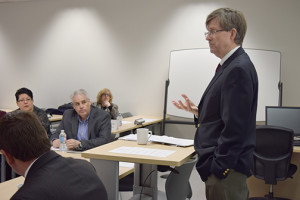Premier’s Workforce Panel Recommendations Good Fit for Colleges
Posted on Wednesday, July 27th, 2016
It’s in the DNA of colleges to be partners with business. Since their inception in 1967, Ontario’s publicly funded colleges have had a primary focus to prepare students to fill the workforce needs of the province’s employers. They’ve done this by staying connected to industry to ensure the curriculum being taught to students is relevant and by building a huge network of partnerships with employers that allow students to gain on-the-job training while in school.
 Now, a provincial panel looking into what Ontario needs to do to keep its workforce competitive has made several key recommendations. The Premier’s Highly Skilled Workforce Panel was chaired by former Renfrew-Nipissing-Pembroke MPP Sean Conway, who calls the panel’s work, “A matter of urgent and pressing priority driven by changing demographics and evidence that the future net growth of Ontario’s labour force will be provided through immigration.”
Now, a provincial panel looking into what Ontario needs to do to keep its workforce competitive has made several key recommendations. The Premier’s Highly Skilled Workforce Panel was chaired by former Renfrew-Nipissing-Pembroke MPP Sean Conway, who calls the panel’s work, “A matter of urgent and pressing priority driven by changing demographics and evidence that the future net growth of Ontario’s labour force will be provided through immigration.”
Here are the six key overarching recommendations made by the panel:
- Building stronger partnerships between educators and employers by establishing a new Planning and Partnership Table, supported by a new Workforce Planning and Development Office within government. Employers, educators, labour, government and others would work through this table to drive solutions for skills and talent development, and for experiential learning. And Industry Tables would address mismatches between the skills that industries need and what the workplace offers
- Increasing access to job market information by working with the federal government to help lead the creation of a national system to give employers and job-seekers better access to information such as where jobs exist and which skills employers will need in the future
- Expanding opportunities for learning by experience by funding more placements so that every student completes at least one experiential learning opportunity before graduating from high school, and another before finishing college or university
- Promoting both traditional and non-traditional career paths by increasing students’ exposure to options including the arts, science, engineering, technology, skilled trades and entrepreneurship
- Investing in human capital by launching programs to support training in the workplace and encouraging large employers to share successful training programs with small and medium-sized enterprises
- Closing gaps in skills and competencies by finding ways to teach and recognize the skills that students learn, such as teamwork, problem solving and entrepreneurial spirit, and by developing training programs for groups underrepresented in the workplace to allow them better access to employment opportunities.
While preparing its report, the panel visited several Ontario communities and spoke with dozens of stakeholders about the most pressing workforce needs. One of those visits was at Algonquin College’s Waterfront Campus in Pembroke where more than 25 local business and education leaders provided feedback from a rural Ontario perspective.
 The benefits of building a strategy to integrate retiring military personnel into the civilian workforce was an idea that surfaced at the Pembroke session and found its way into the report. There was also a lot of discussion about the need for more support to guidance counsellors to help student transitions from high schools to post-secondary and the ongoing need to have timely data on labour market trends and opportunities. These ideas also garnered attention in the report.
The benefits of building a strategy to integrate retiring military personnel into the civilian workforce was an idea that surfaced at the Pembroke session and found its way into the report. There was also a lot of discussion about the need for more support to guidance counsellors to help student transitions from high schools to post-secondary and the ongoing need to have timely data on labour market trends and opportunities. These ideas also garnered attention in the report.
During a news conference announcing the panel’s findings, Premier Kathleen Wynne stated, “The panel’s recommendations will not stay on a dusty shelf,” and Minister of Advanced Education and Skills Development, Deb Matthews, called the report “An aspirational document that provides a framework to build a truly integrated partnership that links the education system with businesses.”
There is no question that Colleges will continue to be an integral part of the government’s plans to address its workforce challenges, but the report clearly states that there is still work to do, such as the expansion of co-operative education placements for more college students.
In the final analysis, the recommendations are intended to help Ontario prosper and they place business-education partnerships at the centre of the plan. That’s good for colleges and even better for students and employers.
Read the full Building the Workforce of Tomorrow: A Shared Responsibility report >>
Read more reaction to the Panel’s Recommendations:
- Ryerson University Article
- The Learning Partnership Article
- Colleges Ontario Media Release
- Huffington Post article
- CTV News Story
Posted by Jamie Bramburger, Manager of Community and Student Affairs
- Posted in
- Waterfront Campus Blog